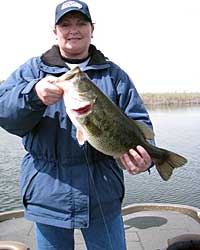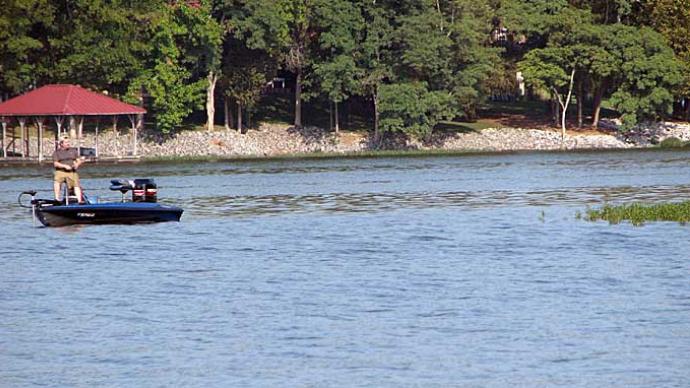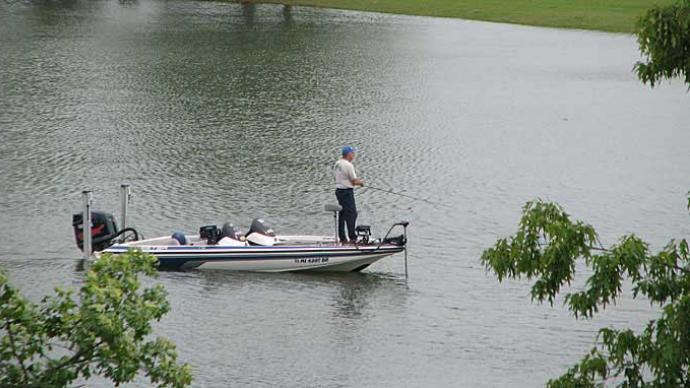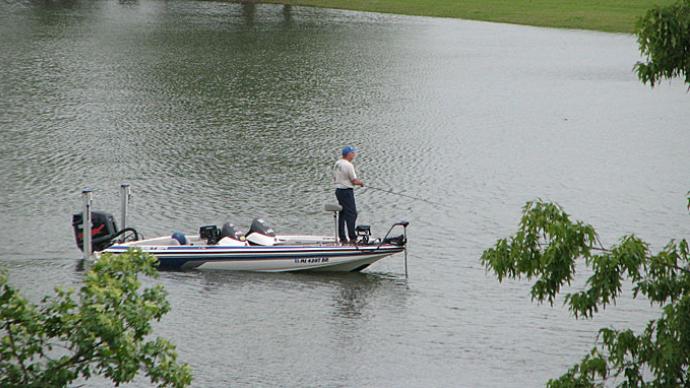
Bass fishing can be defined as either very good or very hard on a given day. However, this interpretation can often vary widely between the perceptions of two different fishermen.
For example, while I was living in Houston, a neighbor professed that he wanted to learn how to bass fish. We started the training with some backyard introductions to the fine art of casting and a trip to a local sporting goods store, where we made a few selected purchases that enabled him to have a modest but reasonable selection of crankbaits in the necessary colors.
Lake Livingston was new at this time, and bass were everywhere. Nevertheless, I had found several schools, which were as reliable as clockwork and permitted a novice to entice them with shad-colored cranks or even hold on the 10 minutes needed for him to detect a strike on a worm.
The game plan was simple: I put the boat parallel to a wood line and told him to cast to the indentation, which was the intersection of an old logging road with the edge of the timber. The bass were there, as usual, and each of his efforts to swim the crank back to the boat was met with a savage strike of a fish desperate to get its meal before another one of its cousins in the school could get the morsel.
After catching 15 or 20 fish, we repeated the process at "secret hole" number two. I then heard the comment, which stirred a primitive urge within me (implanted from the caveman era). That urge was to strangle the guest in my boat. The comment was simple, "Fishing for bass is really easy, isn't it?" I smiled and said something appropriate like "Sometimes!" I overcame my urge to answer with, "Yes, why it took me no time to fish this three-mile strip of the wood line and find this one 50-yard stretch where they were in a holding pattern? The other place was a giveaway location since it was on a bend in the river. But, of course, there are only six zillion bends in the river between Whites Creek above highway 19 and the dam."
True enough, if you fish often enough, you will have days when fishing is easy. It becomes easier for most avid anglers if they work hard and use a sound strategy when planning an approach to fishing on a given trip. However, if you fish much at all, you will also face those days when you know from experience fishing is going to be tough without ever making your first cast. One of those situations, and the ways to develop successful strategies for such conditions, will be the topic of our present article.
A bluebird day is one "dreaded" condition that some folks feel is a real downer. If you wish to fish in shallow water and it is going to be a calm windy, and bright bluebird day, then you have to come to grips with the fact that your best productive periods are going to be limited to the low-light periods of early morning or late in the day. If there is any wind, then the problems of increased brightness are partially overcome by the ripples' disruption of light penetration at the surface. This condition extends the periods of lower light intensity in the shallower waters. In fact, if you fish a shore on which the wind is causing considerable agitation, you can often ignore that it is a bluebird day due to the combination of lower light intensity and the fact that forage often accumulates in such areas. The same ripple that stirs the shallow water in such areas creates all sorts of additional mixing of small food sources, which attract baitfish. And where there are baitfish, there are sure to be predators such as bass. One thing you need to remember about bass is that they can see much better in water than we often think they can.
If you have very clear water and bright days, you have certain limitations that you must overcome to catch fish. To begin with, the bass can also see you better on such days, so stealth is a valuable part of your presentation. The closer you think you are to bass in such conditions, the more "stealthy" you need to become. If you are making long casts, the issue is less critical. Likewise, fishing in deeper water makes you less likely to be a distraction to the bass simply because the light and their inherent ability to see surface detail decrease with increasing depth.
If you buy into the concept that a calm bluebird day in clear-water lakes poses a problem, consider some ways to combat the issue. To begin with, the bass can "see" or recognize things in their environment easier on such days, so there are lure selections you can make that place you in a better position to induce a strike. You don't need to use the brighter colors you might select in lower light conditions. Likewise, a bass can "see" not only better but also with a better ability to detect detail. Thus, you do not have to use larger baits to have the same visual appeal as in lower-light environments. Some are those who get concerned with bright bluebird conditions, but I like to fish in such conditions and have had good success by following a few rules. The first is to use the most natural appearing color to mimic the food source I believe they are feeding on in a given area. If you consider the options for colors, you will conclude that various tones mimic various food sources, ranging from very bright to very pale.
Several years ago, I was working a fishing show where my friend Jim Bagley introduced his Small Fry series of baits. Jim had found me early on when he began introducing the line of balsa plugs. This was partly through word of mouth since I was immediately labeled on several tournament trails as a "crankbait guy." To the worm purist, this was somewhere in the scheme of things ranging from a compliment to a sneer (depending on where you finished in the tournament). Nevertheless, I was addicted to the "machine gun" style of fishing with cranks. A few years later, several touring pros used this same style to achieve success on the major circuits. Jim wanted me to comment on what I thought about the new line of realistic baits. My first reaction caught him off guard. I wanted assurance he would not drop the Bagley B line of plugs and the colors he had offered in this line. I told him I was sure each of the baits looked realistic and would probably be great in clear water and good light conditions. However, his existing baits would probably outfish them in other conditions. The shock was evident on his face. He commented, "You mean you do not think the bream is as realistic patterned bait as you have ever seen?" I explained that indeed it was and that I had no doubt that another bream would probably fall in love and propose to the bait in clear water but that his chartreuse and firetiger colors would still (in my humble opinion) outfish it in anything but very clear water on bluebird days.
Jim gave me the look of an angry parent and shook his head. Then some guy who had also been with Jim's promotional team since the beginning of his company was asked what he thought of the new line of products. The fellow was from Memphis and was known as a crankbait guru in his area. He had been an insurance salesman but was making a run on a newly started national fishing circuit. He responded, "Jim, you are still going to make the Bagley B's in the colors you now offer, aren't you? You know that the tones of the original colors will show up better in most conditions other than real clear water?" At that point, I began to giggle and got a stern look from the lure godfather. He mumbled, "Why did I ask Dodson and Dance anyway?"
There are ways to take advantage of bright days and use the conditions to get strikes. To begin with, you need to shift your fishing emphasis to deeper water and deeper presentations if you are going to fish more open water. Bass will come up to strike a bait if they are in an aggressive feeding mood. However, they are often more easily enticed to strike during bright conditions if they go parallel or down to hit the presented lure. Knowing this fact, try using deeper diving crankbaits or a soft plastic such as a worm, Slug-go, or lizard. I separate these soft plastics from jig-and-pig combinations in that these can be used as a slow drop bait if you use sufficiently light lead, whereas a jig-and-pig is more of a lure that is worked in the bottom strata of a given depth of water. When using a worm or lizard on clear bluebird days, occasionally work the bait back to the boat with a swimming action. The same action may be much too fast for bass to be easily seen in lower light conditions, but in clear, bright conditions, the bait and its action can be seen a distance away. If this style of presentation sounds like a take-off of a crankbait presentation, then so be it because crankbaits catch fish, after all.
Another suggestion for fishing in clear water on bluebird days is to experiment with various colors of soft plastics. Take advantage of the better visibility in such water and see if variations in color or tint will make a difference. Often one slight change in color will trigger more strikes. This concept includes the offering of two-tone baits, particularly with contrasting tails. The logic is simple, the bass can see better and is less reliant on vibration and outline for identification of potential prey when they can see them with extreme clarity.
Bass will tend to be deeper on clear bluebird days but remain shallow if given an option. One reason they go deeper is to get away from the brightness of the sunlight. This is when areas with cover overcome this issue. The ideal location in which bass will stay shallow during bluebird days is where there is some cover. The cover can be manmade or natural. Ideal and often overlooked holding areas are cross-timbers under bridges. These offer a shallow platform with shifting but constant areas of shade and areas frequented by forage fish. Bass are often on the top or immediately adjacent to the cross timber. The key is to determine the shade areas and keep the bait in this zone. A bridge in deep water may hold fish only at the top level of the cross timber, so letting the bait fall to the bottom is often a waste of time.
Many folks have not caught a bass over eight pounds yet, but one gentleman on Lake Fork caught four over 10 pounds last summer. It becomes even more interesting when you learn that the fellow is an avid crappie fisherman working a small Bass Assassin on the top of the cross timbers or along the first 10 feet of the sides trying to catch crappie at the time.
Another source of productive fishing during bright light conditions is manmade structures such as the various piers and boathouses. To fish them most successfully, it's best to learn the fine art of pitching or flipping. In addition, a silent entry of the soft plastic bait or jig-and-pig is also a must. Furthermore, most of the time, the productivity of the cast will be determined by how well you present the lure into the shadows and how long you can work the shade on the retrieve.
The final target, which holds shallower bass in bright conditions, is vegetation, logs, or brush. If it offers shade, the bass do not as readily leave shallow water just because of bright conditions. If they are holding tight to the shadows, you will have to present a lure within the holding area to induce the most strikes. It should be weedless, thus the advantage of soft plastics or jig-and-pig combinations. If you are lucky, you can fish thicker moss or hydrilla. Under these conditions, the bass really don't care about the sunshine in that they are under a perpetual cloud cover that offers shade and cooler temperatures. Mix in the fact that plants make oxygen and that smaller creatures that offer food sources like the same vegetation, and you have the making of a "bass heaven."
From the perspective of the bass fisherman, the bass "motel" offers an area where the bass will stay shallower and can be reached by using a sufficiently weighted jig-and-pig or pegged Texas rig to permit the lure to "crash" through the green stuff and into the dining room of the bass. It has always amazed me that just as a jig specialist assured me, the bait usually goes in weedless and picks up any green stuff on the way back out. Thus, the game plan is to present the bait into the pockets and work it up and down just enough to keep it from entering into the green stuff on the upward movement to fouling the bait with vegetation.
You can successfully find and catch fish on bluebird days and in bright conditions, but not if you use techniques suited for lower light conditions and fish in areas that the bass have vacated in search of sanctuary from the sun.




